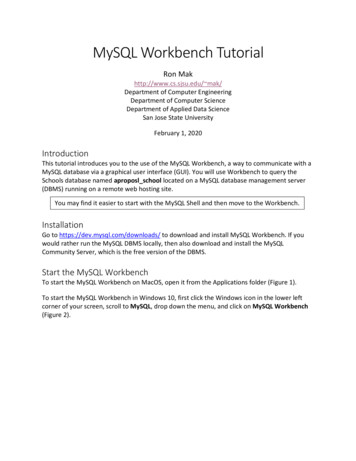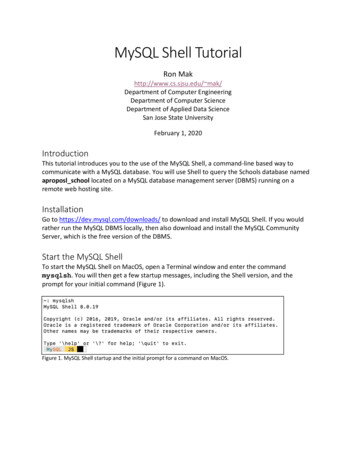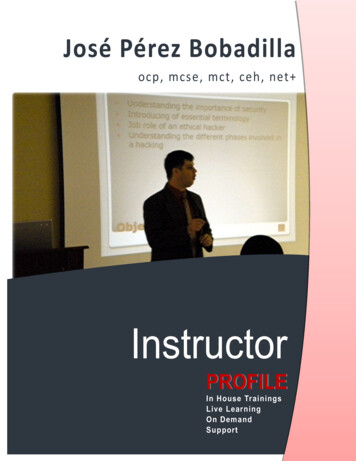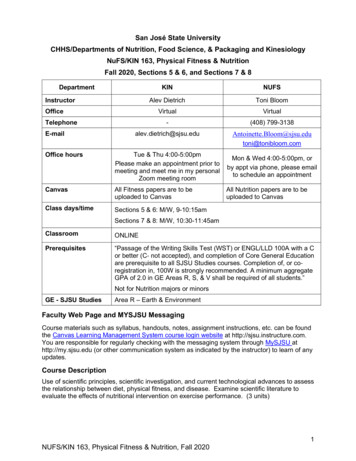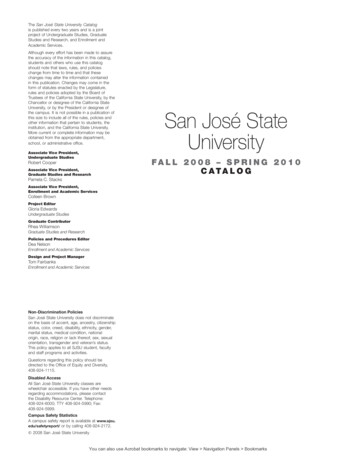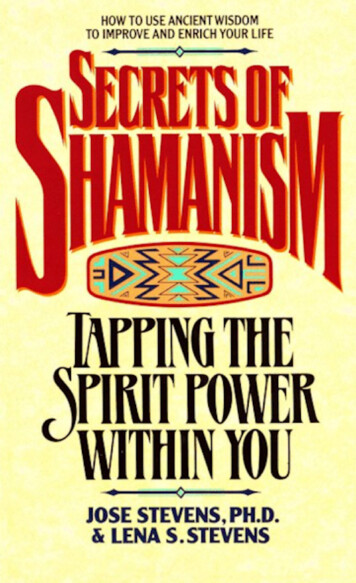
Transcription
Jose Stevens is an internationally known teacher,consultant in organizational effectiveness, andexecutive coach residing in Santa Fe, New Mexico.He holds graduate degrees from the University ofCalifornia at Berkeley and from the CaliforniaInstitute of Integral Studies and a bachelor'sdegree from the University of Santa Clara. He isthe author of nine books including TransformingYour Dragons: How to Turn Fear Patterns intoPersonal Power. Co-founder and trainer of PowerPath Seminars , he leads executive wildernessretreats focused on the principles in this book.Lena Stevens is an internationally knownteacher, healer, business consultant, co-founder,and trainer of Power Path Seminars innovativemethods. Residing in Santa Fe, New Mexico, sheconducts workshops and seminars on shamanismand developing unique and intuitive businessapproaches. Her focus includes working withwomen and power.The Stevens lecture throughout the United States,Canada, Russia, South America, and Europe.
ATTENTION: ORGANIZATIONS AND CORPORATIONSMost Avon Books paperbacks are available at special quantitydiscounts for bulk purchases for sales promotions, premiums, orfund-raising. For information, please call or write:Special Markets Department, HarperCollins Publishers Inc.10 East 53rd Street, New York, New York 10022-5299.Telephone: (212) 207-7528. Fax: (212) 207-7222.
JOSE STEVENS, PH.D.& LENA SEDLETZKY STEVENSProduced by The Philip Lief GroupAAVON BOOKSAn Imprint of HarperCollinsPubiishers
AVON BOOKSAn Imprint of HarperCollimP*Ww m10 East 53rd StreetNew York, New York 10022-5299Copyright 1988 by Jose and Lena Stevens & The Philip Lief Group,Inc.Published by arrangement with The Philip Lief Group, Inc.Library of Congress Catalog Card Number 88-91497ISBN: 0-380-75607-2www*avonbooksxomAllrightsreserved, which includes the right to reproduce this book orportions thereof in any form whatsoever except as provided by theU.S. Copyright Law. For information address The Philip Lief Group,Inc., 319 East 52nd Street, New York, New York 10022.First Avon Books Printing: August 1988Avon Trademark Reg. U.S. Pat. Off. and in Other Countries, MarcaRegistrada, Hecho en U.S.A.HarperCollins is a trademark of HarperCollins Publishers Inc.Printed in the U.S.A.OPM 25 24 23 22 21 20 19 18 17 16If you purchased this book without a cover, you should be aware thatthis book is stolen property. It was reported as "unsold and destroyed"to the publisher, and neither the author nor the publisher has receivedany payment for this "stripped book. *9
For our wonderful children,Anna and Carlos
We are deeply grateful to:our family and friends, whose wonderful supportand encouragement made this book possible;our fellow students of the shamanic way for theirexperiences and insights into modern-day shamanism;our power animals and guardians, whose adviceand information gave this book direction;Inetz Walker for her editing, typing, and allaround help in completing this manuscript ontime;Philip Lief for his support and effective efforts ingetting this book into print;Louise Quayle and Kevin Osborn of The PhilipLief Group, Inc., for their fine editorial assistance.
ContentsPrefaceChapter 1—Shamans: An OverviewShaman SpecialtiesShamans and SocietyThe Making of a ShamanWhat Shamans KnowBenefits of ShamanismChapter 2—Beginning the Journey:Soaring into the UnknownWhat Is Imagination?How You Limit Your ImaginationWhy Use Imagination?Detachment and SurrenderThe Nuts and Bolts of VisioningBeginning the Shamanic JourneyUnderstanding Your JourneyBenefits of JourneyingChapter 3—'The Secret World:What Shamans KnowThe Web of PowerThe Human Spirit BodySeeing Others' Spirit BodiesDefining Your Own Spirit 3638384051515355
XCorrrerrraBecoming TransparentShape ChangingDeveloping Neutrality586162The Power of RocksLocations of PowerThe Power of AnimalsThe Power of PlantsThe Power of the Elements6668758082Chapter 4—Nature's Power: Spirit Helpers64Chapter 5—Shaping Time: Learning to Be Present 87PresenceChapter 6—The Circle of Life:Creating and Destroying100103Creating and Destroying104Appropriate Destruction: Possessions106Appropriate Destruction: Beliefs108Appropriate Destruction: Habits111Appropriate Destruction: Relationships 113Creation115Creating with the Help of Guardian Spirits 118Balance and Imbalance120The Infinite Potential of the Spirit World 124Creating Balance: The Giveaway125Receiving127Chapter 7—Shamans and Opportunity:Goals, Problem Solving, and Success 130DetachmentKeeping Up to DateProblem SolvingChange133135138146Tunnels to the Spirit World157Chapter 8—Finding Your Place in the Shaman'sWorld: Maps and Trails153
CorrrwrrsGuarding and Monitoring the TunnelsHealing Others Using the TunnelsChapter 9—The Sacred Marriage:Discovering BalanceHead, Heart, and Gut PeopleBalancing the BodyMagnetic and Dynamic: Feminine andMasculine Principlesxi169173174174183185Chapter 10—Transformation Through Ritual andCeremony: Practices193Simple Opening Ritual196Opening Ritual for Journeying or OtherShamanic Process197Power Songs198Shamanic Dancing200Using Quartz Crystals for Protection andEmpowerment203Creating a Clear, Safe, and Powerful Place 204Creating Your Own Power Spot205Vision Quest206Harnessing Power Through Light210Chapter 11—Playing the Shamanic Game of Life:The Big Picture211How to Know That You Are BeingSuccessful at Shamanic PracticeHow to Go FurtherAppendix—Shaman's Resource GuideFurther ResourcesBibliography215217221223224
PrefaceThis is a book about success, the success of the shamanover the ages and the success that you can achieve by following the shamanic way.We wrote this book because we saw a need for the ancientart of shamanism to be reframed in the context of thetwenty-first century. This has been particularly challengingbecause we have not wanted to change the meaning of anyintegral concepts but simply to make them more available tothe everyday person. We did not want to be purists in thisendeavor either, but rather pragmatists, weaving basic shamanic approaches together with age-old understandingsabout consciousness.What follows is a short history describing the paths thatled to our writing this book.loseHow did I, a Basque-Mexican-Irish-American, becomeinvolved in the world of shamanism? Answering this question brought numerous half-forgotten memories to the surface of my awareness. I discovered that many threads wovethe rich pattern of my current interest in shamanic ways. Asa small child growing up in East Hollywood, California, Ispent much time with my Mexican grandmother, who filledme with stories of her childhood and the brujos of the YaquiIndians in northern central Mexico, where she had lived. Shewas in awe of them and, being a fervent Catholic, shecrossed herself many times as she told me strange tales oftheir methods and practices. She herself practiced some oftheir ways, and to my impressionable young mind, the magicand power of the shamanic perspective became a way of life.1
2SECRETS OF SHAMANISMI learned in childhood that I had "eyesight" in the palms ofmy hands; that I could read energy with them; that I coulduse my hands to ward off dangers or rid myself of unwantednegative influences.Later I was introduced to the northern Native Americanperspective by Strongheart, a friend of my father whoworked in the film industry. A part-time actor and film consultant, Strongheart would drop by my father's stage-lightingbusiness, where I helped out. I was always impressed by hislong hair, clawlike nose, and gentle demeanor. He did notteach me anything formal, just talked in his native styleabout the way he saw the world.Perhaps these were some of the influences that led me toknow that I wanted to become a psychologist and counselorfrom my earliest childhood. Perhaps this as well motivatedmy solo journey throughout India, Nepal, and Thailand,seeking alternative perspectives and ways of looking at reality. That journey would connect me with powerful teacherswho only reinforced my already "eccentric" outlook on life.Those travels also solidified my relationship with Lena, mywife-to-be, who waited patiently for me while pursuing herown shamanic training.Later I embarked on a series of psychic training coursesthat introduced me to powerful techniques that I recognizedas shamanic in origin. This three-year period of formal training is what eventually led me to select the study of "PowerAnimals, Mental Imagery, and Self-Actualization" as thetopic of my doctoral dissertation. My research led me to discover that people who actively used animal imagery in theirdreams or reveries were actually more self-actualized andmentally healthier than people who did not. The statisticsshowed that they tended to be more present, more selfmotivated, and more positive in their attitude toward life.This just confirmed what I already knew: that the shamanicapproach leads people to greater success and effectiveness inthe world.During my doctoral studies at the California Institute ofIntegral Studies I had the wonderful opportunity to meetteachers who not only were knowledgeable about shamanismbut practiced it in their daily life. Angie Arrien, expert inBasque shamanism and Ralph Metzner, master of transformative metaphors, each assisted me in my studies interfacingWestern psychology with shamanism. I was fortunate enoughto meet and study with anthropologist and shamanism expertMichael Harner, a truly excellent teacher and guide.
Jose ATID LENA STEVENS3During this time I met many others who were studyingshamanism and applying it in their daily lives with incredibleresults. A group of us formed a shamanic practicing groupthat met weekly for years to apply what we had learned andshare discoveries with one another. Out of it evolved theEmpowering Circle, a group devoted to working with othersusing shamanic techniques.I had long since learned that the more I practiced shamanic techniques, the better I felt and the more effective Ibecame in all areas of my life: as a parent, psychotherapist,channel, teacher, and business person. As I applied shamanism to my therapy practice and seminars, I discovered thatnot only were people open to it, but they were actually starving for these age-old methods of effective living. They became more insightful, more personally responsible, morecapable of reaching their goals in a shorter time, and hadmore fun doing it. They also became healthier and sufferedfrom fewer physical complaints.I also discovered through my own children that shamanism is a natural approach to life, a perspective trained out ofus through school and culture. What I discovered is that mychildren are naturally shamanic in their perspective and areexceptionally powerful when they use their inner skills tosolve problems.As I write, lecture, channel, and work with people, I consistently find that my most profound teachers are thoseguardians and allies whom I discover within. These are mytutors, my constant guides that provide me with valuable information and insight when I am confused or in need. Theyare the ones I have perhaps drawn the most from in writingthis book. In truth, Lena and I wrote it together with them.We offer it to you as a helper. May your path take you to thelight of self-discovery, the center of the universe.Jose Stevens; Berkeley, California; January 1,1988LenaMy informal training in the shamanic perspective began ata very early age. Born of Russian-Polish-Swedish parents, Iremember fairy tales in which animals were the helpers andguides, always assisting people out of trouble and helpingthem achieve great riches and happiness. I have had a greataffinity for animals ever since. When I was seven my familymoved from the city to Carmel, California, where I spent the
4SECRETS OF SHAMANISMrest of my childhood and adolescence. The magic and powerof the Big Sur coast, an area where I spent much time backpacking in the woods, affected me deeply throughout myformative years. Many of these outings, in a land revered byNative Americans as sacred, revealed power spots and magical places that greatly strengthened my inner bonds with nature. One incident that brought the unseen power of naturehome to me was a near-fatal fall off a steep embankmentwhen I was thirteen years old. For all practical purposes, Ishould have been seriously injured if not killed. I distinctlyremember the fall as if suspended in time: me falling, butsomehow not touching the rocks and trees I was bouncing offof. It was as if some unseen cushion were guiding me downto place me gently in the creek two hundred feet below. Icame out of the experience with only slight scratches andbruises, and with an altered feeling of great respect for thepower of the spirit world. At that point, I also knew that Ihad allies who were helping me through life.Perhaps knowing about this protection was what spurredme to take a year-long trip through Europe, trusting that Iwould meet the right people and always have enough to getby on. I was then twenty-one years old. My travels eventually took me to the far north of Sweden on a trek through thecountry of the Lapps. There I experienced intensely luciddreams and feelings of d6j& vu. Years later work with a psychic revealed a past life as a shaman in that northern region.I devoted the rest of my twenties to intense studies in therealm of shamanism, psychic awareness, and channeling aswell as business. Since my interests in art and music were notputting money into my bank account, I turned to real estate,to the surprise of my friends and family. The field for me hasturned out to be an excellent vehicle for learning to negotiatein the business world using my now deep-rooted shamanicperspective and intuitive skills I developed in years past. Mytransition into management has been a natural way for me toteach what I know about the shamanic world to the salesagents, brokers, and clients I deal with on a daily basis. Theshamanic perspective has become so much a part of me andthe way of our family life that I cannot imagine living anyother way. The fact that Jose and both our children share thesame perspective has given us much joy. We are truly gratefulto be able to share what we have learned with you in hisbook.Lena Sedletzky Stevens; Berkeley, California; January 3,1988
Jose ATID LENA STEVENS5Although both of us have encountered near-death experiences, neither of us has undergone severe initiatory trials,nor have we received formal initiations as shamans. We donot believe that formal initiation is necessary to allow one tobenefit from the shamanic perspective. Nor do we believethat severe suffering is necessary for a person to learn thevalue of the inner ways. Historically, extreme hardship andsurviving severe trials has often been the only way that somepeople were willing to embrace the shamanic way of life. Webelieve there is another way, the way of slow, gentle learningabout the powers of the inner world.Two different approaches to learning are reflected in theway people come to learn the shamanic method. In the first,novices must undergo profound and often life-threateningexperiences that propel them into shamanic work. Afteryears of practicing the traditional techniques and forms, theygradually learn how and why the methods work. They canexplain shamanism to themselves and perhaps to others. Thesecond style of learning reflects more of the modern Westernapproach. Here novices learn about shamanism graduallyand are gently guided into its ways, being able to explain it tothemselves as they go. There are advocates of both ways andwe believe that because people are vastly different, there arepeople who learn better under one style than another. Perhaps the best way to learn is a good mix of both hands-onexperience under the tutelege of a teacher, a little selfreflection, and flying by the seat of your pants. There is nosingle right way to do it. Whatever way you learn will be theright way for you.
CHAPTER 1Shamans: An OverviewIt was an opportunity of a lifetime, an offer seeminglyjust out of reach. For years Shawna had wished for theanthropologist's dream: an assignment to Lima, Peru,jumping off place for the Andes. And now a group wasbeing formed and she was asked if she wanted to go. Butthe obstacles seemed almost unsurmountable. Slavingover a maze of reports from her last assignment, Shawnawas not even remotely ready to go. She was also flatbroke. Shawna spent hours in the July heat of Los Angeles calculating the costs, pouring over the calendar,and figuring in any possible assets she could turn intocash. Neither the figures nor the dates on the calendaradded up.In frustration, Shawna threw her pencil across theroom where it bounced and spun into her favorite cottonwood drum, a gift from her grandfather in New Mexico.He wasn't really her grandfather but she called him that.Old Bill was everybody's grandfather. Shawna had spenta few summers with the ancient Apache and now shesuddenly recalled something he had taught her. "Whenyour heart is sad and you have lost your path, go insidefor help. When your heart speaks its truth, you cannotknow failure." Suddenly Shawna relaxed. How could shebe so foolish as to give up her dream because of a fewcalculations?Swiftly crossing the room, she picked up the drum.Sitting quietly for a time, she began to sing a little songOld Bill had taught her, accompanied by a light drumbeat."Falcon I am calling, Falcon I am calling, Come and bewith me." Closing her eyes, Shawna could see theebony of the falcon's wing feathers as he flashed by her."Falcon," she whispered, "I could use a little help. I wantto go to Lima but as you can see I am stymied. Any suggestions?" The image of the falcon appeared to look herstraight in the eye and say without opening his beak,"Melanie, call Melanie. You will go, you will go." Then hevanished across an imaginary horizon.Shawna rubbed her eyes. Melanie? The only Melanieshe knew was a former employer from pre-graduate6
Jose ATID LENA STEVENS7school days; a prim, exacting woman whom Shawna hadalways found somewhat hard to please. Melanie alsopossessed power, money, and influence where it counts.It started to dawn on Shawna.The following morning found Shawna on the phonewith Melanie. "Ah, hello, I'm Shawna Michaelson, I usedto work for you and—" Shawna was amazed. Not only didMelanie remember her but she also showed a genuineenthusiasm for Shawna's Peruvian plans.They agreed tomeet the very next day.Ml can't believe you called me," Melanie exclaimed."I've been hoping to start a foundation for scholars buthad no focus as yet. Now I've got something to start with.How much will you be needing?"Shawna's mouth fell open. "I, I, I don't know. Fivethousand dollars will go a long way in Peru.""Good," stated Melanie, "lets make it six for good measure. That's a good beginning for this year's endowment."Excited beyond measure, Shawna decided she nowmust get down to that paperwork. Then she caught herself. "Falcon's working on it. I'm not going to fail. I'm goingto Peru."On her way home Shawna stopped at a gas station."Hi, Shawna," a familiar voice called. It was her supervisor, Larry Jackson, from her last job, which was in Montana. He said, "I'm in town for some lectures at U.C.L.A.and was going to call you. I want Terry, that doctoral student, to finish those reports you're working on. It will begood practice for him and give you a break. What do youthink?"Larry wasn't expecting the big bear hug Shawna gavehim. She mumbled thanks and hustled home to get heraffairs in order. "Let's see: passport, shots, cold-weatherclothes. Thank you, Falcon! My friend. This assignmentis starting out right!"Shamanic advising is an ancient and powerful form of information retrieval and inner consultation that can beadapted by anyone for use in the context of the modernworld. Shamanism itself is a time-honored cross-culturalquest for knowledge and personal power that predates allknown religions, psychologies, and philosophies. A set oftechniques developed over ages, it allows individuals to learnconsciously to bridge the apparent chasm between the physi-
8SECRETS OF SHAMANISMcal world and the realms of imagination and vision. The greatadvantage of this form of guidance is that it requires no outside tools, no expenditures, and very little time investment.In fact, you might be tempted to overlook it because it doesnot fit into what we think of as a traditional path to success,whether personal or professional.The shaman relies on inner powers to support his or herconclusions about a situation, rather than on material concerns as is often the case today. The only price you have topay to use this form of consultation is that shamanism asksyou to let go of your conventional belief systems about reality.While shamans have no fixed dogma or religion, they allbelieve in the universal web of power that supports all life.According to shamanism, all elements of the environmentare alive and all have their source of power in the spiritworld. Rocks, plants, animals, clouds, and wind are chargedwith life and must be paid due respect for the maintenance ofharmony and health. Shamans consider all life-forms to beinterconnected, and a mutually supportive balance amongthem is essential for humankind's survival. Our job is to understand this balance and to live in harmony with it, alwaystaking nature into consideration in every endeavor. The webof power in nature is the life giver and the source of all successful activity.Shamans access vital survival information and knowledgethrough what is known as a spirit journey. As shamans put it,they travel within their imaginations to contact the spiritworld or the world of the spirit self: they contact the universal source of all information by "flying" deeply within themselves. If they do this while focusing on a question or matterof concern, their ecstatic journey will provide an answer, allowing them to bypass the stumbling blocks of the materialworld and rely on a broader vision.Yat squatted by the water's edge lifting handfuls of thecool drink to his lips. Although his thirst was quenchedthe water did nothing to ease the ache of hunger he andhis scouts had felt these past five wintery days. If they didnot find his brother's village soon they would surelystarve. They made a hasty camp by the snowy riverbedand bundled in skins by the fire. Yat knew it was time tocall for assistance. Drawing forth his drum he began asteady spirit song honoring his totem spirit, the kangaroorat. With eyes closed he soon saw kangaroo rat flying inthe air nearby. "Oh, rat, my friend, I have a special re-
Jose ATID LENA STEVENS9quest. We cannot find my brother's village and we haverun out of food. Can you help us find it?" Rat continued tohover for a moment and remained silent. Then with aflourish rat produced a large branch with a fork in it. Hepointed to the left fork and in a flash was gone. Yat waspuzzled. He pondered the vision and after a time beganto laugh loudly. In the morning he led his companions upthe stream. Shortly the river forked into two smallerstreams. Immediately he followed the left-hand one andbefore long the village was in sight. Yat once again gavethanks to kangaroo rat.SHAMAN SPECIALTIESFor shamans, imagination is more than cerebral activity,rather, imagination is an actual vehicle that carries them tounknown realms. Thoughts and feelings are forms of energythat go to specific locations in the web of power, not simplymental activity as most of us have been taught to believe.Shamans fill a diverse and fascinating set of roles including sacred artist, poet, musician, mediator, ceremonialist,dancer, and singer. Four principal specialties of shamans are:healing; accessing new or lost knowledge; developing power;and prophesying or foretelling. Although most shamans havea knowledge of all these areas, they also tend to focus on onein order to master it. For example, curanderos or healersspecialize in learning about the power of medicinal plantsand herbs for the healing of infirmities. Other shamans develop the ability to forecast the weather, locate good opportunities, and warn of potential hazards. Still others becomepower brokers, masters of suspending the laws of gravity orspace and time. Whatever their speciality, they are the medicine men and women of their communities and are found allover the world from North and South America, to Europe,Africa, and Asia. The shaman's power as visionary, seer, andhealer has been traced to Siberia, India, and Tibet. Similartechniques have been utilized everywhere by shamans sincePaleolithic times even though they were separated by vastoceans and continents.In this book we will touch on all four principal areas ofshamanic activity because they are integral to developingyour power and becoming a successful human being in yourown right. In addition we will provide you with exercises thatdraw from the shaman's artistic skills. Unless you can develop the artist within you, you will not be able to enjoy theshamanic approach.
10SECRETS OF SHAMANISMSHAMANS AND SOCIETYAccording to anthropologist Michael Harner, an experton shamanism, shamans have always been pragmatists, doingwhatever worked best to increase their reputations as powerful healers and visionaries. If the shamans' methods worked,they earned respect and a good reputation. If the shamans'methods did not work, they lost credibility. Through trial anderror they found what actually proved effective and then applied their newly found knowledge with astonishingly successful results. In this way shamanism has survived throughthe ages despite a variety of persistent widespread attemptsto wipe it out by: missionaries, who felt that it represented athreat to the vertical authority structure of their religions;the advance of science, which considered shamanism unscientific and subjective; the age of reason, which discardedshamanism because of its nonrational approach; the adventof technology, which superceded the nature-based shamanicperspective.Despite earlier interpretations that shamans were simplytolerated psychotics, recent anthropological studies have revealed that shamans are actually the most productive, stable,and intelligent members of their communities. They oftenprovide for many dependents through their efficient andshrewd handling of goods, livestock, and items of trade.Thus each community and tribe depends heavily on the localshamans for their knowledge and guidance because theyhave dedicated themselves to gaining knowledge and accessing power for the good of others.Perhaps the most intriguing aspect of shamanism is thefact that it is truly a grass-roots phenomenon. There exists nodogma, no organization, no special texts (although we will begiving you examples and suggested exercises in this book),no leaders, no regulatory board. Anyone can practice itstechniques and derive benefit from its methods. Historicallyany male or female who exhibited the talent or who had anintense desire for this personal spiritual quest could practiceit. Shamanism has always been a people's spiritual practice.Each shaman has the right to access new information andnew knowledge with no threat of expulsion or condemnationfrom any organized belief system.THE MAKING OF A SHAMANHow does one become a shaman? Typically individualsare initiated into shamanism in three ways: they are either
Jose ATID LENA STEVENS11self-selected; they are selected to be trained by older shamans, sometimes after having survived a life-threatening accident or disease; they inherit the role of shaman from theirfather or mother. Whatever the method of selection, shamans have traditionally undergone a long training period andoften have had to pass a rigorous and sometimes brutal testbefore becoming a shaman in their own right. We are notproposing in this book that you become a shaman or that tobe successful using shamanic techniques you need years oftraining or brutal initiation; many have found that the shamanic techniques translate successfully for use by the ordinary person and can definitely aid in the enrichment andsuccess of life.Actively using your shamanic abilities, however, is not apanacea for all problems. Shamanism will not eliminate theobstacles in your life. Shamanism can make solving thoseproblems less of a chore—and it'll probably make you moresuccessful at solving them, too—but you still have to takeaction to get the results you want. Tribal shamans, for example, may use their powers to help hunters locate the herd.But knowing where the herd is doesn't eliminate the challenge of the hunt or the job of skinning the animal and preparing the meal. You can use your own shamanic powers inmuch the same way, by being able to place yourself in theright place at the right time. Once there, you'll have to depend on your own abilities to succeed, but the edge you'vegiven yourself will make your job that much easier.What makes a shaman different from other members ofhis or her community? What are the ingredients that makeup a powerful shaman? What do shamans know that makesthem special or gives them that added talent for healing andcoping with life? Let's take a moment to preview some ofthose qualities and beliefs. In subsequent chapters we will gointo greater detail and give you pointers on how you canbegin to develop these qualities in yourself.WHAT SHAMANS KNOWThere is much that shamans know and many qualities thatthey possess. Below are listed a few of these characteristics: Shamans know about energy and how it works both in theenvironment and in the human body. They recognize theinherent power in all of nature and sense their own connection with it. They know about the spirit body and howto communicate with it for health and extra stamina.
12SECRETS OF SHAMANISM They have learned to relax their physical bodies and toreduce their level of stress so that they ar
Chapter 3—'The Secret World: What Shaman Knos w 38 The Web of Power 3 8 . The Powe or f Plants 80 The Powe or f the Element 8s 2 Chapter 5—Shaping Time: Learnin tgo Be Present 87 . and power of the shamanic perspective became a way of life. 1 . 2 SECRETS OF SHAMANISM I l





